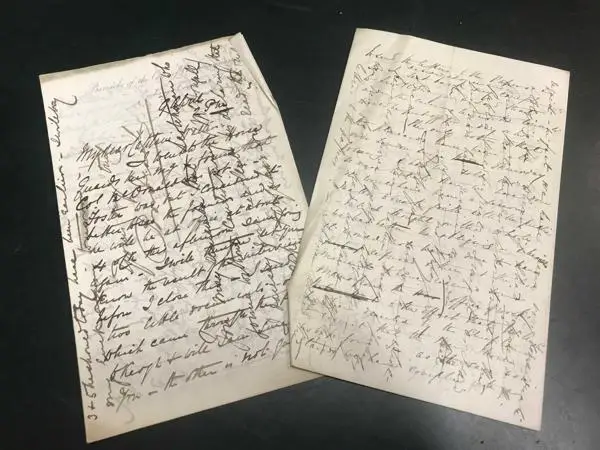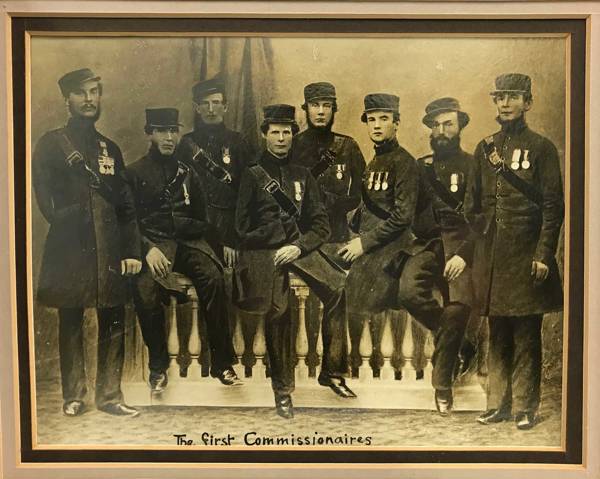Corps of Commissionaires: Security with a Soul
In 1859, a retired cavalry officer of 8th Hussars, Captain Edward Walter, who had recently fought in the Crimean War, came across one of his former soldiers on a London street. The veteran was now a destitute beggar: men like him, suffering from what would now be diagnosed as PTSD, many of them amputees, had no place in respectable Victorian society, where they were deemed unemployable. Captain Walter decided to change this by offering the veterans the opportunity to earn a living in a dignified way as security guards. His groundbreaking idea set the wheels in motion for a trailblazing and extremely successful organisation, the Corps of Commissionaires, the oldest security company in the world, which over 160 years later is still very much active as Corps Security.
We are pleased to announce that the Corps archive – which runs to 17 linear metres – has recently been catalogued and is available for consultation at LMA under reference number LMA/4777. The records date back to the foundation of the Corps in 1859 and beyond: they also include documents relating to Captain Walter (or, as he is respectfully and affectionately referred to throughout the records, the Founder), going back to 1824.
Essentially an employment agency for ex-military personnel, the Corps of Commissionaires was run personally by Captain Walter with the help of two adjutants for the first six years of its existence. Initially providing protection for London’s financial houses, its uniformed members soon gained a reputation for reliability and high standards of service and became renowned for exemplifying their founding values of ‘loyalty, integrity and service’. As the Corps began to expand, in 1865 Captain Walter secured the support of HRH the Duke of Cambridge and the services of distinguished officers as Governors to help manage it. The Corps remained a family-run organisation until 1975, with all the Commandants in charge hailing from the Walter family until that date.
The first Corps barracks were established in London, in Exchange Court in the Strand. Soon, however, the Corps began to expand across the UK and beyond: between 1876 and 1919, out-quarter divisions were established in Belfast, Liverpool, Glasgow, Edinburgh, Manchester, Birmingham, Newcastle, Bristol and Nottingham. 1884 saw the formation of the Australian division in Sydney.
The early history of the Corps, the ethos behind it and circumstances leading to its creation, development and subsequent success are particularly well documented through a comprehensive range of documents that include the Founder’s correspondence, general orders, minutes, rules and regulations. The Founder’s correspondence includes letters from well-known individuals such as Florence Nightingale, members of the Royal Family, and military grandees of the day. Unlike most of the collection, these original letters are available for consultation with the depositor’s permission only; permission can be requested by contacting the Corps Security Archive Custodian at archives@corpssecurity.co.uk.

The development of the Corps, the challenges it faced, the public image it wished to project, and changes it went through can also be glimpsed from newspaper cuttings, meticulously collected over the decades. This is likely due to the fact that the initial financial means for the realisation of Captain Walter’s vision came from his family: his grandfather John Walter founded the Daily Universal Register in 1785, a newspaper which became better known as The Times. Edward’s father, also John Walter, was its second editor.
The Corps archive also contains comprehensive admission and discharge records of its members. The first employees of the Corps – known as ‘the original eight’ – were seven soldiers and one sailor disabled in the Crimean War; all of them were amputees. By 1939, its ranks had swelled to over 5,000. Initially Corps members were drawn exclusively from ex-military personnel, but in 1969 were joined by former police and fire officers. The Corps opened its membership to women in 1974. However, although the archive provides detailed personal information of those who joined the Corps, there is no existing record of commissions taken up by individual members during their time in the Corps, or of their employers. It is worth noting that some of the admission and discharge registers are currently unavailable for general access due to data protection regulations.

The Corps of Commissionaires’ archive provides a fascinating insight not only into the history of the organisation itself, but also into social history, as it addresses the issues of disability, identity, respectability, and public perceptions of the security profession and the ex-military. Since its foundation, the Corps may have been incorporated as a company, rebranded as Corps Security, with its Commandant replaced by a CEO and headquarters relocated from the Strand barracks to an office in Cowcross Street, but it remains faithful to its original founding principles and social values. Its ongoing support of veteran charities, such as Combat Stress (mental health) and Blesma (limbless veterans) would make Captain Walter very proud indeed.